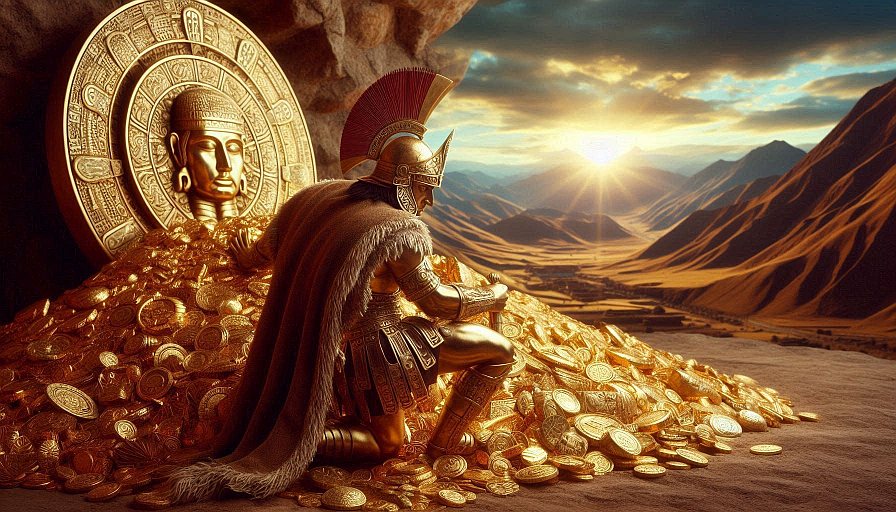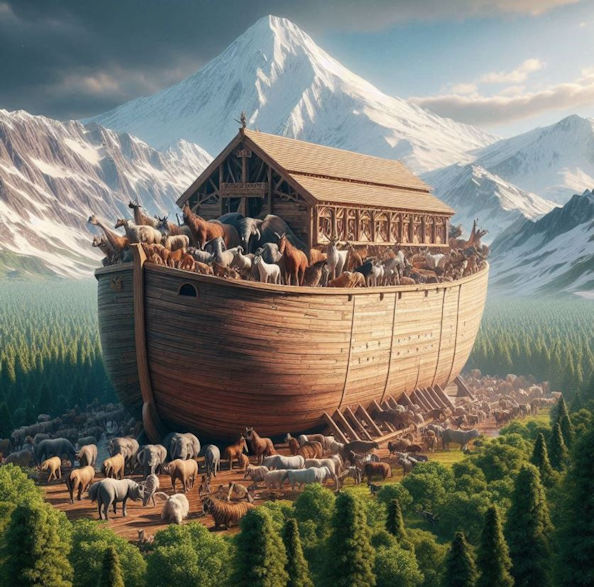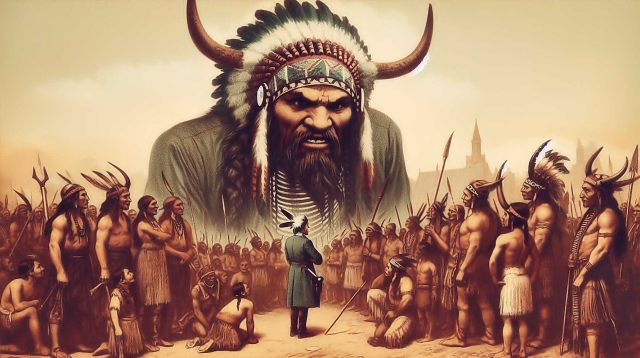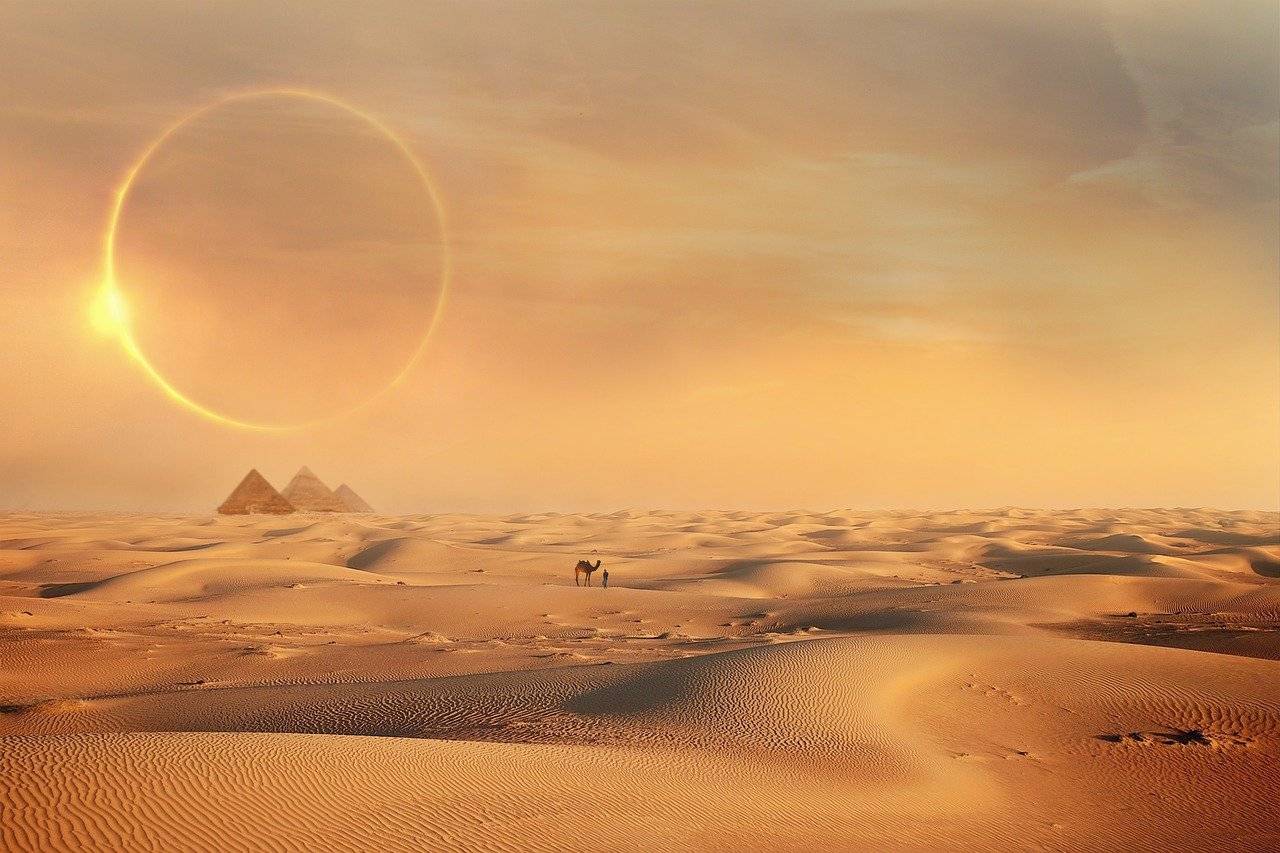
Ancient Egypt was rife with the practice of magical spells and the occult. For many centuries, Europeans considered Egypt as a country where secrets of magical arts were preserved and taught, more than any other country.. Part of this belief was based on the fact that for centuries the great city of Alexander, Egypt had a fantastic library said to house half a million books on all subjects and visit by readers from all over the world, but that great library was burned twice. First, by Roman Emperor Julius Caesar in 48 BC when he was pursuing Pompey into Egypt and Caesar was suddenly cut off by an Egyptian fleet at Alexandria, Greatly outnumbered and in enemy territory Caesar ordered the ships in the harbor to be burned. The second and final destruction of the Great Library of Alexandria came under the armies of Roman Emperor Theophilus, between 270 and 275 AD, who also was the Christian Patriarch of Alexandria that turned the Temple of Serapis into a Christian Church.
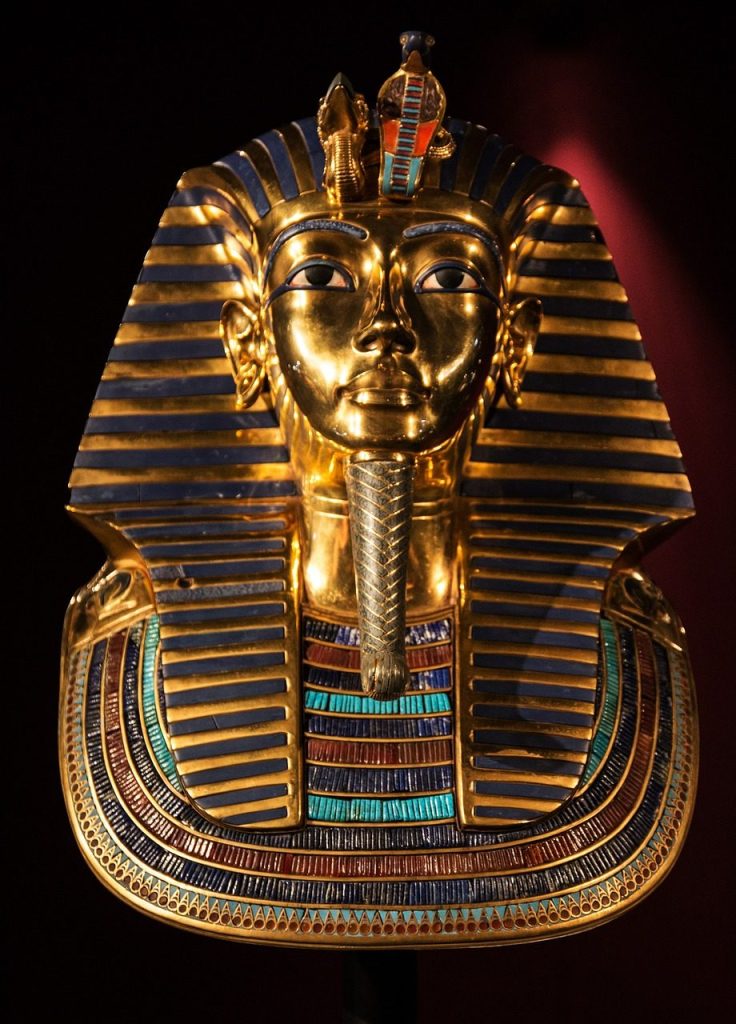
The vast majority of Egyptians carried tiny images of their gods or goddesses or both as amulets and talismans for good luck, success, and protection from evil. At the funerals of important ; affluent people, priests performed magical rituals with prayers to help the deceased individual in the afterlife. In the graves of wealthy Egyptians, the priests played various sacred objects believed to be imbued with magical powers for the benefit of the deceased individual’s spirit. One good example of such a thing is the “ushabti”. A ushabti is a small figure buried in an ancient Egyptian tomb with the mummy very often bearing inscriptions from “The Book of the Dead” and representing servants expected to do various agricultural labors mandatory of the deceased, by order of the gods, in the land of the dead. Often, these magical funeral figurines were made with the servant image holding a hoe. The word “ushabti” translates into “answerer” since the ushabti would answer to the work required of the deceased by being a substitute worker for the deceased. Consequently, tombs of Pharaohs would have hundreds of ushabtis; the tomb of Tutankhamun, the boy Pharaoh of ancient Egypt, had 413 of them. Ushabtis were made out of almost any ancient material, including stone, wood, clay, metal, or glass, but the most common material used in making ushabtis was called Faience. Faience is a type of ceramic, but without clay that was glazed and fired in a kiln. The ushabti, also known as “shawabti” or a “shabti” were commonly made of blue or green glazed Egyptian Faience, and these generally mummiform figurines are about 5 to 30 centimeters (1.969 inches to 11.811 inches) in height. The shabtis from Tutankhamun’s tomb were intricately carved and very ornate, while a shabti from the grave of a poor farmer was much simpler. Some people were so poor that with their burials in ancient Egypt there were no shawabtis.
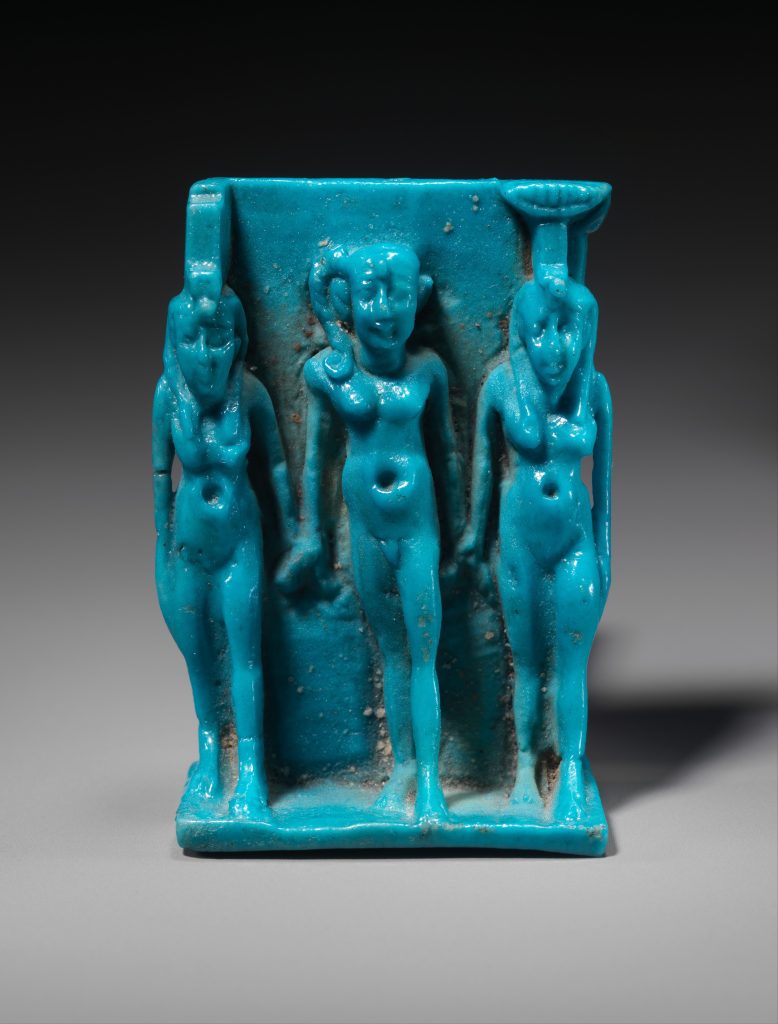
Egyptian, Late Period
Faience; H. 4.5 cm (1 3/4 in.); W. 3 cm (1 3/16 in.)
The Metropolitan Museum of Art, New York, Purchase, Edward S. Harkness Gift, 1926 (26.7.890)
http://www.metmuseum.org/Collections/search-the-collections/550957
There are also many scrolls and books of magic from ancient Egypt. The oldest of these documents were written down and illustrated on papyrus paper in strong, durable ink. There are volumes from ancient Egypt on astrology, alchemy, magical spells and rituals, talismans, amulets, and charms. Books on magic and occultism often have numerous prayers to Egyptian gods and goddesses. These such prayers are recited and other times written on many talismans and amulets or on different times both recited with others written down. The majority of the ancient Egyptians carried an ankh or key of life cross. This item is a regular cross but the top part only has a big loop. A string, rope, or wire through the loop was used for carrying or the ankh charm. The ankh could also be bonded to an object by being tied with rope, string, or wire. At times, people briefly carried a big ankh by holding the loop part through their fingers. The word “ankh” translates into the word “life”, which the Egyptians understood to be “eternal life”. The loop represents a circle, and a circle has no beginning nor end. The circle would signify the celestial world, the spirit of Ra, the Sun God of the ancient Egyptians. Major gods and goddesses of ancient Egypt, such as Osiris, Ra, and Isis, and Egyptian Pharaohs were at times illustrated by carrying a big ankh from grasping the loop in their hand. In ancient legends, gods and goddesses gave out extra ankhs to certain people as sacred gifts and charms for blessings. Ancient Egyptians also carried an ankh symbol to bring them good luck. Ankhs were commonly depicted in ancient temples. Some people believe the form of the ankh developed from a sandal strap. Ankhs were made from metals such as bronze and gold to gold with silver alloy(electrum) to glazed ceramics, wood, and stone. At funerals, an ankh image was often placed with the body of the deceased to revive human souls in the afterlife.
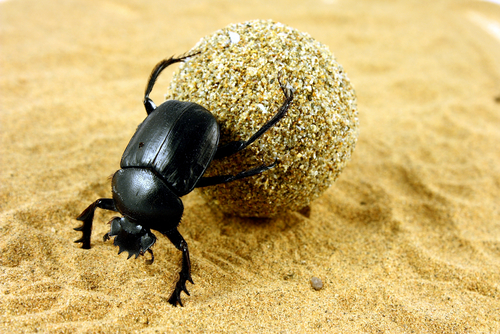
Scarabs-these are images of the Egyptian female dung beetle which could be seen rolling a big ball of its manure of which the beetle has previously laid her eggs in. At first, the adult female beetle laid her eggs in the dung, then buried the dung under the sand or soil. When the eggs are close to hatching, the female scarab digs out the manure ball and then rolls it around to try to find a better birthing site. The lavare will eat their way out of the manure ball. To the ancient Egyptians, the scarab sacredly symbolized the manifestation of an early morning rising sun over the eastern horizon at daybreak under the Sun God Ra. The ancient Egyptians saw the scarab as a sacred symbol of renewal and rebirth. The ancient Egyptians thought the sun would die at night and be re-born the next day. The people of ancient Egypt did not know that sun we see everyday is the same sun. This phenomenon was called “Khepri”. As an amulet or talisman, the scarab was thought to bestow divine power associated with the sun; strong sunlight as growth (crops grow with the sunlight), warmth (healing; well being), light (enlightenment), and so forth. Images of scarabs with long, spread out wings were placed on mummies in their linen cloths as amulets for the mummies to be blessed with the beneficial arms (as sunlight emanations) of the Sun God Ra. Scarabs were made of various materials with glazed steatite being the most common, These amulets usually have their bases inscribed or decorated with designs. Scarabs also showed up in ancient Egypt as talismanic seals. The seal type of scarabs were most common, particularly clay seal scarabs. Inscriptions of sacrabs some times were mottos which referred to places, deities, good omen interpretations, good wishes, and there were scarabs for royalty that bore royal names inscribed thereupon. Many ancient Egyptians carried a scarab for good luck.
When the female scarab beetle is not pregnant with little beetles, she , like the male scarab beetle will gather up pieces of manure, manure from themselves or other creatures, roll the poop together to create one big mass, and at times travel a little bit while rolling the poop. Then the beetle or beetles(male and female) will eat the manure for nourishment. There are times that two unrelated dung beetles (sacrabs) will fight each other over the possession of the poop ball. There are approximately 6,000 species of dung beetles found on every continent except Antarctica. Dung beetles do not eat flesh but will eat carrion. There are rare mummified dung beetles(sacrabs) from ancient Egypt that were found. Youtube has such videos. The Eye of Horus-the god of ancient Egypt whose body is of a man but the head and neck of a falcon. Horus was the god of war and the sky. He is often imaged as wearing a crown with a cobra or the Double Crown of Egypt. The hooded cobra (uraeus) that the gods and pharaohs wore on their foreheads, symbolizes light and royalty. Horus was married to the goddess Hathor. Hathor is the goddesses of love, beauty, music, dancing, fertility, and pleasure, She is usually depicted as a woman with the head of a cow, ears of a cow, or simply in cow form. When the Israelis were freed from bondage from Egypt, they melted down metal chiefly gold, and worshiped, temporarily, to the anger of Moses, a golden cow, which was an image of Hathor. Horus is the son of Osiris, the god of the dead, and Isis, the goddess of the dead, and magical healer. The right eye of Horus represented the sun or morning star that is imbued with physical power and the left eye of Horus represented the moon or evening star that is imbued with healing power. As a god, Horus has superhuman strength, endurance, resistance to harm and general injury.
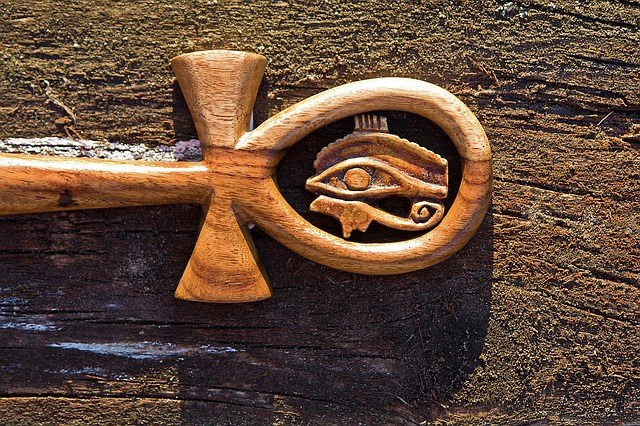
In ancient Egyptian legend, Horus loses his left eye in a fight with Seth Seth is a sky god, lord of the desert, master of storms, chaos, disorder, and tricks. The eye was magically restored by Hathor, and this miracle came to symbolize a complete, regenerative healing. The eye of Horus image was used by ancient Egyptians for both healing and protection, especially against disease and to help prevent the disintegration of the embalmed body of a corpse, Some people carried the eye of Horus symbol for good luck. Other people believe the eye of Horus image chases away evil spirits, especially when placed on a pendant with a mummy. The eye of Horus charm was made at times from stone, other times faience glazed ceramic, fire heated clay, and other materials.
Ancient Egyptian magical practices have fascinated many people for thousands of years. In the Old Testament Bible, Araron the brother of Moses, threw down his staff that turned into a serpent. The magicians at the court of the Pharaoh dis the same thing and their staffs turned into serpents, but the serpent from Aron’s staff ate all the cobras. produced by the Egyptian magicians. Afterwards, Aaron picked up the cobra which changed back into a staff or rod. And in ancient Egypt, there was a powerful magician called Dedi or Djedi of Djed-Sneferu who delighted royalty with magical feats including decapitating an animal, then magically restoring the animal’s head. Dedi was also a prophet. He is said to have worked wonders during the reign of Pharaoh Khufu of the 4th Dynasty. The fourth chapter of a story told in the legendary Westcar Papyrus is quite descriptive about Dedi (Djedi). Djedi is ancient Egyptian for “He who endures”.
